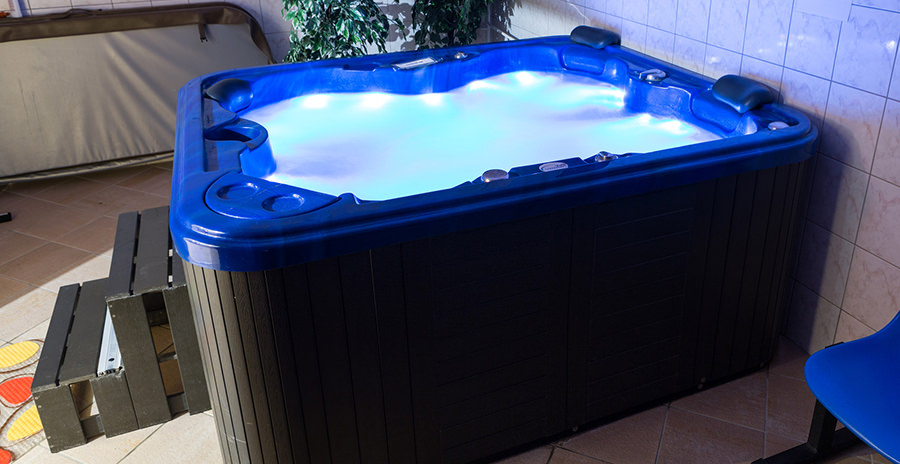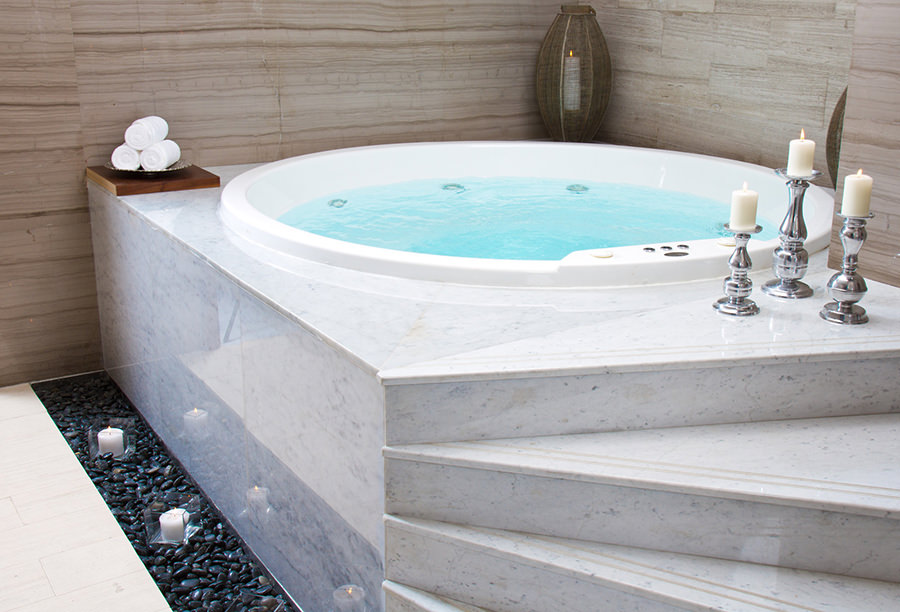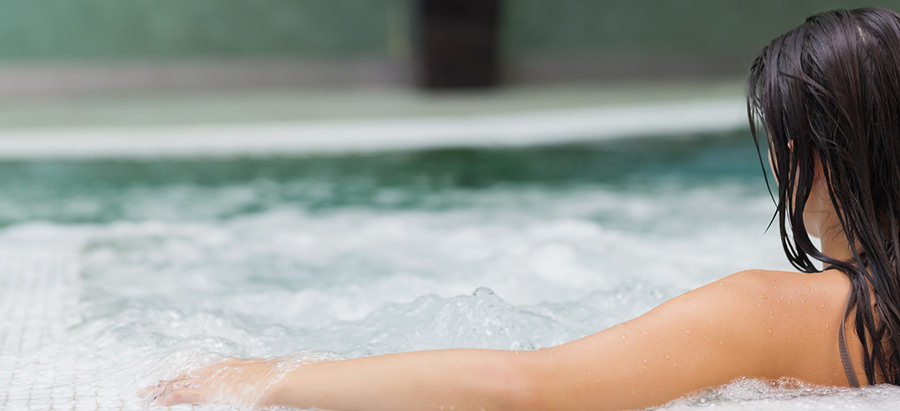
When I think about hot tubs, I usually imagine relaxing outdoors in the open air, enjoying the warm water. However, the other day, it occurred to me to wonder whether it’s actually possible to put a hot tub inside. After all, just because we don’t tend to see indoor hot tubs doesn’t necessarily mean that they don’t exist! I decided to take a look into it, to find out the truth of the matter.
Can you put a hot tub inside? Yes, you can have a hot tub inside. Hot tubs can be installed either outdoors or inside a house. In fact, it’s sometimes easier to install your hot tub indoors when compared to outdoors, but of course, the experience will be different depending on whether your tub is outside or inside.
If you’re keen to maximise your privacy and your comfort, an indoor hot tub could be the ideal solution. However, there are a few special considerations that need to be borne in mind when installing a hot tub inside your property.
What Special Considerations Are There To Bear In Mind When Installing An Indoor Hot Tub?
There are a few important things to keep in in mind when you install a hot tub indoors rather than outdoors:
Choose the right area in your home – the first consideration is to select the right area of your home in which to install the hot tub. You’ll need to make sure you avoid any flooring which could turn slippery when it gets wet. Whenever you get out of a hot tub, a surprising amount of water comes out with you, so it’s essential to choose a flooring material which maintains good drainage and traction when it’s wet.
Carpet and wood surfaces are both out, since they will rot. Astroturf is also a bad idea, since water seeps under it, causing rot to set into the base. Non-slip, matte-finish tiles are the best option, and you should consider installing a floor drain to allow for easy drainage and clean-up afterwards.
Wherever you put your hot tub having a sturdy pair of steps to safely get in and out is vital, as is a good handrail. You can see my recommended choices on my page here.
Convenience of a water source – most hot tubs don’t need any external plumbing, however, even in these cases you’ll require a handy nearby water source to fill up the tub.
Install drywall in the room – although putting a tight-fitting cover over your hot tub when not in use will keep the moisture safely inside, whenever you take the lid off, you’ll find the room will steam up quickly. Of course, this isn’t a problem which would occur with an outdoor hot tub, but when you install one inside your property you could find that, without the right precautions, mildew and mould could quickly set in.
Glass enclosures, cedar linings or cement walls are top choices when it comes to the most appropriate wall materials, or alternatively, you could use water-resistant drywall such as that made for use in kitchens or bathrooms. You’ll also need an intact vapor barrier beneath your wall covering to guard against dry rot setting into the joists and studs.
Install a fan – another important consideration when installing a hot tub indoors is the installation of a suitable fan. You’ll need an extractor that’s quiet yet powerful to remove humidity from the room quickly without disturbing your relaxation when in the tub. When paired with the proper drywall, this will save your structural elements and walls from mold, mildew and dry rot.
There is a whole page of fan options on Amazon here. You will need to make sure that you buy a fan powerful enough to ventilate the size of room that you have as well as checking to make sure it is possible to fit it in your location.
Install adequate heating – not only will you need an extractor fan, you’ll also need to ensure that the room has adequate heating to minimize moisture condensation. Having a ceiling fan can enhance the circulation of air.
Choose the right sanitizing system – nobody wants their home to smell of chlorine. While the usual odor that comes with standard hot tub sanitizing chemicals won’t be noticeable in an outdoor hot tub, it’ll soon become pervasive with an indoor hot tub, even if you install an extractor fan. You should therefore always ensure that you use an odourless saltwater system when sanitising indoors or possibly a UV sanitizing system.

Why Choose An Indoor Hot Tub?
There are a number of benefits to choosing an indoor hot tub as opposed to an outdoor model.
- Privacy – whatever type of neighborhood you live in, installing your hot tub in your house allows you a lot more privacy than an outdoor tub, especially if your garden is overlooked by other properties.
- Convenience – an indoor hot tub is even more convenient than an outdoor one – there’s no need to even leave your home to get into the warm, relaxing water.
- Protection – you won’t need to worry about the weather with an indoor hot tub. It’ll never be so hot and sunny that you’ll need to wear sunscreen, or so cold and wet that you’ll be freezing in the water. Your cover and cabinet will stay undamaged by harsh elements and you won’t need to worry about airborne allergens either.
- Maximises your unused space – if your home is very large, or if your family has moved away, you probably have plenty of extra space. By installing an indoor hot tub in one unused room, you’ll be maximising the use of your floor space in a wonderful way.
Which Features Are Most Important In An Indoor Hot Tub?
There are a number of features which you should definitely be looking for when choosing an indoor hot tub. These include:
- Foam insulation – when you have a foam insulated indoor hot tub, heat will be lost slowly to the environment, making your hot tub more energy efficient and reducing your electricity bills. Foam insulation also provides soundproofing and gives it improved long-term support.
- Adjustable jets – choose a model which enables you to adjust the direction and strength of the water jets so that you can enjoy a more customised experience.
- Maintenance features – an indoor hot tub which features filter cartridges makes maintenance much simpler to carry out. All you’ll need to do is switch the old filters with new ones, then clean the old filters before swapping again after a couple of weeks.
- Warranty – look for an indoor hot tub which comes with at least a one year warranty on its working parts and a five year warranty on its shell for your peace of mind.
- Appearance – when you’re installing a hot tub inside your home, its appearance is especially important. Your hot tub will be a focal point of the room in which it’s installed, so make sure you choose a model which complements your interior décor.

Installation Issues To Consider When Fitting An Indoor Hot Tub
It isn’t easy to install or maintain a hot tub indoors. Before you jump into the installation process, here are some issues which you should consider:
- Installation route – some hot tubs will be bigger that your doorway, so it may be impossible to navigate it around corners and down corridors. Make sure you check the measurements and specifications against your hallways and door frames before buying.
- Base – the foundation of your hot tub needs to be solid, since a full hot tub is very heavy. If you have a basement, this is a good place to install your hot tub however, if you choose to install one on a higher floor you may have to think about reinforcements to your floor.
- Plumbing – if the room that you’ve chosen for your hot tub doesn’t have running water, you’ll need to install a sink and tap.
- Drainage – whenever you get into or out of your hot tub, you’ll find that water can run over the sides onto the floor. Installing a drain in the floor will prevent damage from occurring. It will also make the process of emptying the hot tub a lot easier than using a hose.
- Electrical installation – you’ll need to connect the hot tub to a power source. That means you’ll either need to plug it into a power socket or directly wire it into the mains. You’ll need to use the services of a qualified electrician to ensure that this is done safely and properly.
- Ventilation – an efficient extractor fan will need to be installed to mitigate odors and dampness and guard against the development of mold and mildew due to the humidity and heat.
- Water-resistant construction materials – if you’re going to prevent expensive damage occurring to your walls, ceiling and floor, you’ll require building materials which are water-resistant. Any other accessories or furnishings in the room should also be water-resistant to protect them from the increased condensation, humidity or accidental overspills that could occur.
Related Questions:
Should I Use An Indoor Hot Tub? Most people can use either an outdoor or indoor hot tub perfectly safely without experiencing any problems. However, it’s always sensible to speak to your doctor before you install a hot tub in your home if you suffer from a heart problem or if you have any other long-term health condition which is being treated.
How Do I Choose The Right Indoor Hot Tub For Me? Once you’ve decided to invest in an indoor hot tub, you’ll need to draw up a list of your requirements, specifications and measurements before going shopping. When you know exactly what you’re looking for, you’ll be able to make an informed decision.

